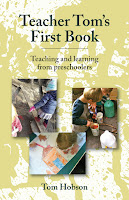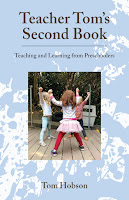"When Sammy put the paper on the wall
She put the parlor paper in the hall
Then she papered up the chairs
She papered all the stairs
She even put a border on grandma's shawl
When Sammy put the paper on the wall
She poured a pot of paste upon us all
Now we're all stuck together
Like birds of a feather
Since Sammy put the paper on the wall."
I learned this song from my mentor Chris David who learned it, I assume, from Bev Bos, who wrote and recorded it with Micheal Lehman, and Tom Hunter. I've never listened to the original, so this version of the lyrics may differ from hers, but I feel, in the spirit of folk music that she wouldn't mind that we, over the years, have changed it a bit. After all, as Utah Phillips said (or maybe it was Pete Seeger), "It's called folk music because it belongs to the folks."
I had to credit a lot of people in the preceding paragraph for this silly song and I probably left lots of folks out. But that's the true beauty of folk music. It is meant to be shared. It is meant for every voice, be it three people around a campfire or thousands in a concert hall. It is meant to spread itself rhizomatically, the way wild strawberries do by spreading roots and runners in any direction in a non-hierarchical and decentralized way.
In her book Orwell's Roses, author Rebecca Solnit (who introduced me to the word rhizomatic) points out that "(t)he branching of trees and roots is often used as a model of lineage: of the evolution of species or languages, as a family tree, as any chronological, branching transmission," but we now know that there is nothing hierarchical about the way trees spread themselves. For instance, we now know that they operate much more like strawberries and folk music. There is a 4000 tree aspen forest in Utah, for instance, that shares a common root system, making it the single largest living organism on Earth. It is about 80,000 years old, meaning it has been living and growing since about the time Homo sapiens began our Great Migration, the second spreading of our species outside of Africa.
I reckon that someone has written the history of hierarchy. I know there are some that insist that it is a natural, evolutionarily adaptive way for humans to organize themselves. The first formal hierarchies emerged some 7500 years ago in Mesopotamia as a way of organizing us into groups of a few thousand individuals. But I think it's legitimate to doubt the naturalness and inevitability of hierarchies. People will point to other primates (like gorillas and chimpanzees) and mammals (like deer and wolves) as examples of natural hierarchy. They will point to alpha males who "dominate," but I've seen plenty of evidence that we may have fallen into the trap of interpreting these animal societies through the bigoted lens of human hierarchy. The way other animals organize themselves seems to be far more amorphous and flexible than the term "hierarchy" implies. Certainly, "human civilization" as we know it seems to always embrace some kind of top-down authority, but just as we now know that the individual aspens in Utah are really a single organism, I think it's legitimate, with an open mind, to consider that we, and other mammals, may be more like wild strawberries than we habitually think.
One of the great challenge and opportunities of society right now is the internet which, famously, is not organized as a hierarchy. Governments and corporations are, of course, attempting to impose hierarchy on it, but the truth is that there is a real rhizomatic quality to the world wide web that may very well overwhelm their efforts. Its ability to spread, like a virus (non-hierarchical bio-machines), threatens hierarchies right across the globe. I'm old enough that I can still remember a world without the web, but the children we are teaching are growing up with it. And I think it's safe to say that we are still in the early days of its spread. I can imagine that if we survive another 80,000 years, the internet will have evolved into a kind of root system that connects us all, spreading the way folk music does, connecting us into societies that more resemble honey bees or a folk music sing-a-long than a Fortune 500 company.
(David Graeber and David Wengrow, an anthropologist and archeologist respectively have taken a fresh look at the historical and archeological record, and written an entire book on this question called The Dawn of Everything, which I highly recommend.)
As a preschool teacher, the adult in a room full of children, I could easily compel a kind of hierarchical system with me at the top, the "smart" or "good" kids just below me as lieutenants, then the rest below us all. And some classrooms are very much organized in this way. I've spent my career trying to avoid that, however. Yes, by virtue of being the adult in the room, I'm responsible for things like safety (both physical and emotional) and in that role I may at times appear as a classic top-of-the-pyramid guy, but it is also my responsibility, as I see it, to give away any power I have by way of empowering the children in my care. The children choose what they are going to do with our time together (sometimes called play), they make agreements (sometimes call rules) about how they want to live together, and their own civilizing structure is one built upon the needs of the moment rather than the dictates of obedience and loyalty upon which hierarchies rely.
Having spent the better part of two decades in this role observing the children, I've seen that power is an ever-changing thing. When one child becomes too bossy, for instance, the others either collectively rise against them or, more commonly, move away. I've seen that knowledge spreads like a rhizome with children teaching children, through example, experience, and direct instruction, connecting them the way the internet is connecting the world, ultimately forging them into a single entity. On the surface, they may look like a forest of individual trees, but underneath there is a shared root system that makes them one. From my admittedly limited experience, it appears that hierarchy, at least in young humans is a learned rather than innate behavior.
When Sammy put the paper on the wall in Bev Bos' version, the pronoun used is "he," whereas we have always sung it as "she," because when our community learned the song there was a girl in our class named Samantha who went by Sammy. But it remains the same folk song, the one that connects us to all the other folks who sing it from the beginning until the end of the world.
******
If you liked reading this post, you might also enjoy one of my books. To find out more, Click here!
"Ready for a book that makes you want to underline and highlight? One that makes you draw arrows and write 'THIS!!!!!' in the margin? Then you are in for a treat." ~Lisa Murphy, M.Ed., author and Early Childhood Specialist, Ooey Gooey, Inc.
I put a lot of time and effort into this blog. If you'd like to support me please consider a small contribution to the cause. Thank you!



